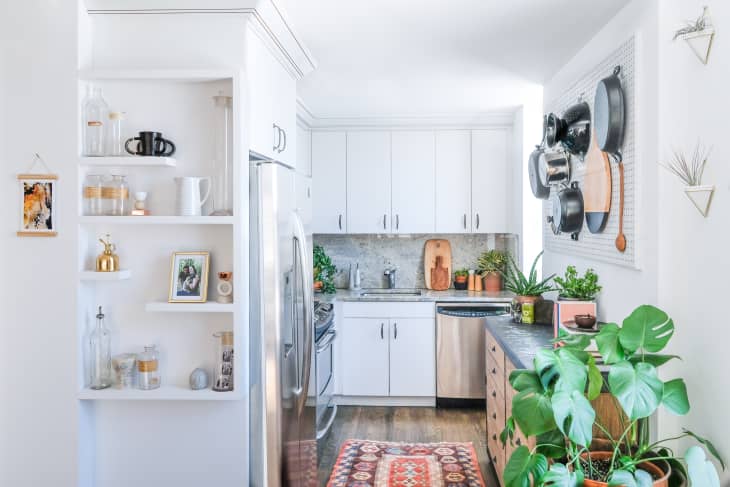4 Professional Organizers Share the Tidying Habits They’ve Ditched (and What They Do Instead)
When I picture aprofessional organizer’s home, I imagine a pantry with perfectly labeled dry goods, linens stacked and sorted by size and color, and offices straight out of a Design Within Reach showroom. But from mypersonal experience, I know that maintaining an ideal level of tidiness is time-consuming at best and anxiety-producing at worst — even for pros.
Curious about how experts strike a balance between the quixotic and the realistic, I asked four professional organizers to share what habits they’ve let go of and why.
Striving for Perfection
One thing Devin VonderHaar ofThe Modern Minimalisthas shed is perfection and the need to get things done right away. “Tidying that takes 20 minutes or less is sometimes left overnight. This includes dishes in the sink, laundry, and random items around the house.” Knowing that everything can be tidied in a short amount of time means organizing tasks don’t have to happen immediately.
Kelley Jonkoff ofUnfoldebelieves in listening to each client’s specific needs and that flexibility is reflected in the habits she’s let go of in the pursuit of people-centric organizing. Among those habits is getting the perfect fold. “I still encourage a file fold or roll, but my focus is much more on what will enhance my client’s life. Often, that means a functional drawer of clothes versus a pristine, aesthetically pleasing drawer with painstakingly folded shirts.” Jonkoff says. “If you don’t want to fold — if that’s a strict non-starter and a barrier to organization — no problem! We’ll hang up whatever we can and throw the rest in bins, or whatever other method we can come up with that works best.”
Decluttering Based on Things You No Longer Want
Pro organizerEmi Louiehas transitioned from an old pattern into a new one with a sharper focus: “When decluttering, my process was to select the items that Ididn’twant. I would pull those items out and then organize whatever was left. Now, I do the opposite. I select the items that Idowant and let go of what’s left. Choosing items that spark joy is key to the KonMari method. When you focus on what you want rather than what you don’t want, you often end up with less volume but more satisfaction, and things are easier to organize and find.”
Following Trendy Advice That Won’t Fit Your Home
此外,路易停止以下建议simply didn’t work, like “Get rid of it if you haven’t worn it in three years,” or “Every woman needs three little black dresses.” She says, “I discovered that those wardrobe rules didn’t apply to how I wanted to live, so I ditched them.” Rather than playing by someone else’s rules, Louie trusts her organizational instincts.
Not Allowing for Lifestyle Changes
Jonkoff’s definition of minimalism has shifted throughout the years and she encourages clients to recognize when their definitions shift too: “While I still very much consider myself a minimalist, I’ve become a lot less hardline about it […] I make a lot more room for my own comfort and quality of life when I consider new purchases. I’m sure this trend is due in part to the phase of life I’m in now versus when I started my organizing career. At that time, I was living in an apartment with my then-boyfriend in a big city. Now, we’re married homeowners hoping to start a family. I often remind my clients that our priorities are allowed to change, and mine definitely have.”
Like Jonkoff, Pia Thompson ofSweet Digsnoticed that her tidying habits have shifted through new phases of life. “Before I had kids, I was very meticulous about all sorts of things. I would clean my purse out every night,” shares Thompson. “Now, I use the same purse for weeks. It’s just not as important. It doesn’t mean I won’t do it at all — I just won’t do it as frequently.”
Not Prioritizing Mental Health
VonderHaar shared that she prioritizes her mental health over tidying. “When [mental health] becomes a daily practice, your space (and your cortisol levels) are more manageable. More calm.”
A recent revelation has also changed the way Thompson approaches tidying: “I have low-level anxiety … this awareness has been amazing for my life. I pay attention to what I do and don’t do when I don’t feel anxious. I do not rush around when I’m not anxious. [When I’m anxious] if there is something in the living room that belongs in the bedroom, I pick it up. But when I’m not anxious, I don’t do that.”
And even though Thompson has let go of this habit of tidying constantly, she notes that because she’s laid the groundwork by following the KonMari method, she knows that everything in her home has a place. Tidying up is easier and therefore can be postponed because she’s made her space efficient and functional. “Here’s the thing about being organized: I know what I own and I know where it goes. So when I decide I have the space to fold, I know where those things go. I’ve done the back work. The KonMari method lets me honor myself and know who I am,” Thompson says.
所有这些组织者有一个共同点s that they don’t aspire to constant perfection. They understand through years of experience that organization should serve life and not vice versa. Through speaking with these professionals, I realized that doing the work of creating organizational systems allows people to let go of daily habits that don’t serve them. When the foundations of a space are organized, it’s OK to break some rules.

